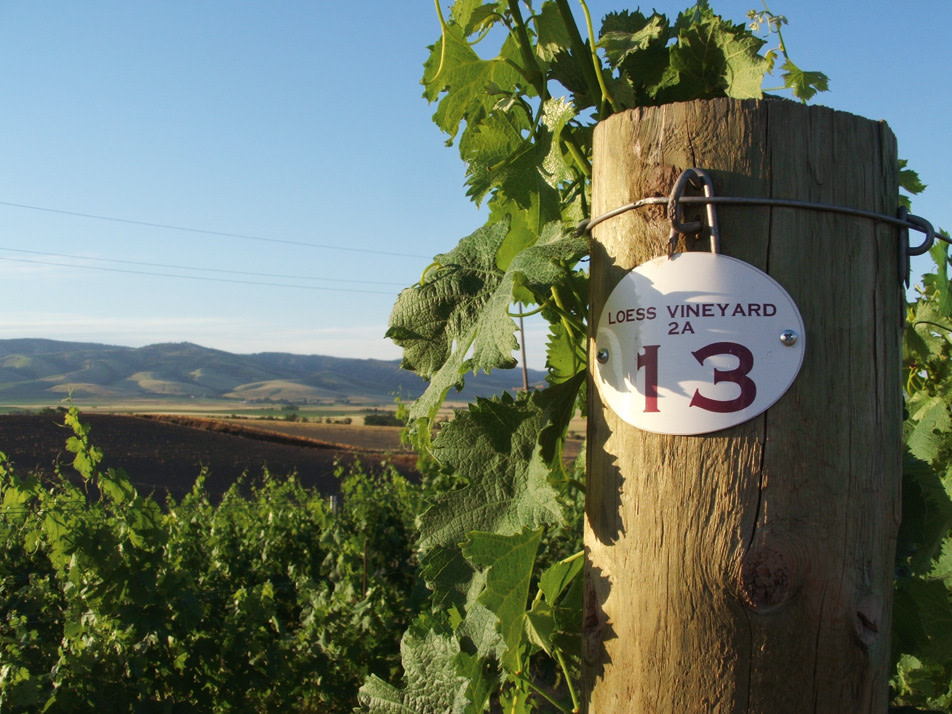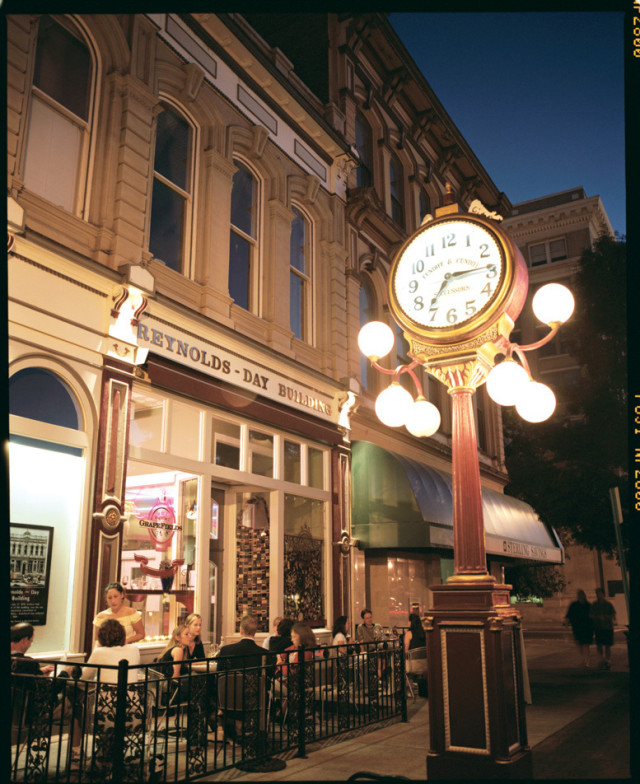Vintage Charms

The Loess vineyard at Leonetti,
one of the wineries that led the Walla Walla renaissance in the 1970s.
Image: Joao Canziani
The exposed brick walls. oversized mirror and chocolate-brown décor inside Saffron Mediterranean Kitchen, a tiny storefront restaurant housed in the space of a departed art gallery, create an atmosphere at once contemporary and homey, a mood that matches the cuisine. Chef Chris Ainsworth, a 32-year-old graduate of New York’s French Culinary Institute, and his wife, Island, just opened the restaurant in May; now he spends his evenings feverishly preparing tapas for the dinner rush, including patatas bravas and Saffron’s signature flatbreads, some topped with caramelized fennel, dates and Serrano ham.
My sister, Jamie, and I are seated next to the open kitchen, dining on arancini (Sicilian-style saffron rice balls) and Kobe beef cheeks in a mirepoix marinade spiked with rosemary. Not only do we agree that it’s some of the tenderest, most flavorful beef we have ever tasted, but we rate the entire dining experience as flawless as any we’ve had in Seattle or Portland.
The winemakers in Walla Walla are actually the people pouring the wines.
Yet when we finally leave Saffron, we’re standing on a side street in Walla Walla, whose downtown, in spite of the proliferation of art galleries and boutiques, seems lifted from a 1950s movie set. Home to Whitman College, this city of some 30,000 in southeastern Washington, once known primarily for the sweetness of its onions, is now gaining a serious reputation for its cabernet sauvignon, merlot and syrah. In fact, wine connoisseurs often assert that Walla Walla is destined to become “the next Napa.” That I find a bit hard to believe. Napa is just an hour or two from San Francisco, but Walla Walla is more than four hours from Portland and five hours from Seattle—too far to attract carloads of day-tripping tourists.
That, of course, is one of Walla Walla’s charms. Drive 10 minutes out of town in any direction, and you’ll encounter vistas of Blue Mountains, seas of grains and pastures dotted with cows. The neat, symmetrical rows of grapes don’t dominate the landscape here so much as contribute to an evolving agricultural patchwork. And yet, the vines’ arrival has altered not only the agronomics of the area but also the town itself. It was Walla Walla’s wine-driven renaissance, for example, that lured Saffron’s Ainsworth, a former head chef at Todd English’s Marriott Waterfront Fish Club, from Seattle last year, after he and his wife visited friends who were relishing the slow-paced, country way of life.
Italians who settled here at the turn of the century brought winemaking to the area, but the first commercial, post-Prohibition vineyard on record in Walla Walla was Blue Mountain, founded by the Pesciallo family in 1950. They grew a little-known red Italian varietal called Black Prince, but closed after a few years. Walla Walla winemaking remained a cottage industry until the late 1970s, when local Army buddies Rick Small and Gary Figgins made several trips to Napa to study its booming business and then began transporting grapes from other parts of the state. Today, Small owns Woodward Canyon and Figgins heads up Leonetti Cellars, and both produce wines that regularly fetch 90-plus ratings from the national wine press.
More than 95 licensed wineries now grace the Walla Walla countryside, owing to a location far enough north to receive extended hours of sunlight in summer, far enough east to be spared heavy rains and high enough in elevation to enjoy cooler temperatures at night, which keeps acidity levels in the grapes where they should be. Although most grapes here are cabernet sauvignon (41 percent), merlot (26 percent) and syrah (16 percent), at least 27 different varietals are grown, according to the Walla Walla Wine Alliance, a fact that may reflect the diversity of Walla Walla’s winemakers, who range from eager viticulture students to retirees.
If there’s one thing these oenologists do have in common, it’s an utter lack of the snobbery that can lend a measure of exclusivity to wine-tasting in other regions. “People are always impressed that the winemakers in Walla Walla are actually the people pouring the wines,” says Elizabeth Martin-Calder, director of the Walla Walla Wine Alliance.
But no matter how laid-back the wine industry, wine tourists tend to expect certain amenities, and for years the lack of upscale restaurants hampered tourism’s ability to grow here. Even after Whitehouse-Crawford, the town’s first white-linen restaurant, opened in 2000, the demand for a variety of dining experiences outpaced supply. “There still wasn’t enough healthy, fresh food,” says Daymon Bruck, a 41-year-old former New York advertising executive who opened the restaurant/gourmet shop Luscious by Nature last fall. Housed in a 1920s-era building, the eatery feels like a small-town diner reimagined by Design Within Reach; for brunch it serves omelettes and even pear-sage margaritas, and also stocks picnic staples like salami, bread and cheese.
{page break}

Grapefields Wine Bar & Café in
Walla Walla’s historic downtown
Image: Joao Canziani
Most of Walla Walla’s wineries are just 10 to 15 minutes from downtown, and a weekender’s best bet for tasting would be to spend one day visiting the 11 tasting rooms off of Pranger Rd, just south of town, and the next at the wineries near the airport, to the east.
The Pranger Rd wineries include quaint, hip and, in the case of Rulo—housed in a farm shed—downright down-home establishments. As Rulo’s Vicki Schlicker pours a taste of the 2005 Combine, a chardonnay-viognier blend, she tells my sister and me that Rulo is named after an old grain elevator outside of town. Schlicker and her husband, Kurt, an anesthesiologist, started Rulo in 2000 after moving from California, and they readily admit that their foray into winemaking was more hobby than serious venture. As such, there’s been a learning curve. “I don’t even know what a marketing director is,” says Kurt. “We’re just dorks who make wine.”
The next day, we head out near the Walla Walla Regional Airport to a bland and boxy row of buildings used by the Army during World War II. The Port of Walla Walla began leasing out the buildings to wineries in 1996; now some 15 wineries have tasting rooms here.
At Russell Creek we meet Larry Krivoshein, who started selling wine in 2000 after 30 years as a funeral-home director. He comes across as a bit surly, and is one of the only winemakers to charge for pours. “If you taste a bad wine, you’re not coming back even if it’s free, right?” he remarks. By the third pour, we realize that Krivoshein is actually a big softy. He devotes an entire wall—one that isn’t covered with accolades, such as Wine Spectator ’s 91 rating for his 2003 Select Merlot—to snapshots of his grandkids.
Down the row, we stop by Dunham Cellars, which sells 22,000 cases a year. Run by 33-year-old Eric Dunham and his parents, Dunham Cellars has become wildly popular. Its 1995 cabernet sauvignon was deemed one of the finest wines in Washington by Wine Enthusiast , and the winery’s Three-Legged Red, a $19 table wine, is a commercial favorite. The label depicts Dunham’s dog, Port, who lost his leg to a pit bull.
By the afternoon, we’re back at the Marcus Whitman Hotel to rest up for dinner. Built in 1927, the 127-room facility has undergone a $35 million renovation, including the addition of conference rooms. Our brand-new suite is positively voluminous, with a sitting room, Wi-Fi and two flat-screen TVs.
When chef Hank “Bear” Ullman opened the hotel’s restaurant, The Marc, in 2001, the former Westin Hotels superstar “threw out the rules” of small-town cooking, along with the menu. Any tendency toward country fare is gone. “You will never see meatloaf on our menu,” says the hotel’s owner, Kyle Mussman, a salt-and-pepper-haired millionaire who made his money in telecommunications and has financed much of the hotel’s reinvention.
Tonight’s meal is a rehearsal for an upcoming winemaker’s dinner at the Marcus Whitman, which hosts them several times a year. This one features wines from Three Rivers, whose 37-year-old winemaker, Holly Turner, is on hand to lend her palate. The seven-course meal, which includes heirloom tomato salad with edible flowers, lobster over fennel and watercress, and elk tenderloin bathed in cherry sauce, lasts three hours. When Ullman likens the gastronomic adventure to “an extreme sport,” we agree he isn’t kidding.
Strolling out of the Marc, we meet a quartet of California winemakers who came to Walla Walla to see what all the fuss was about. They joke that they aren’t going to tell anyone how great it is here, because they don’t want it “turning into another Napa.” Whether it does or not seems beside the point. But the time to visit is definitely now.




